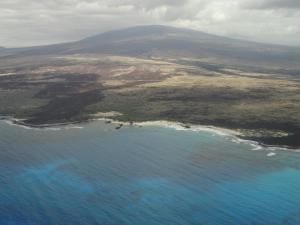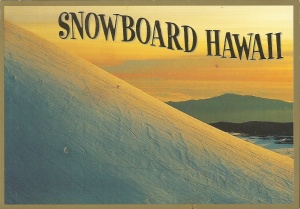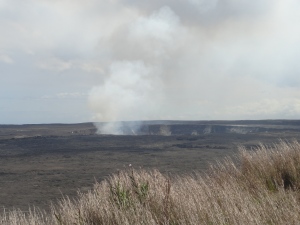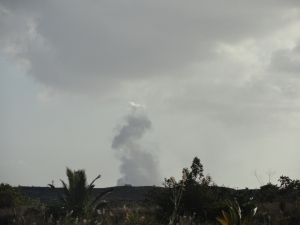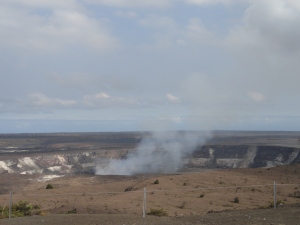 The first time we went to Kalapana, we were lost... I can't remember where we were trying to go, but we were not only lost, but... let's not call it "fighting"... but the attitude in the car was ... "tense"....maybe it was just me...
The first time we went to Kalapana, we were lost... I can't remember where we were trying to go, but we were not only lost, but... let's not call it "fighting"... but the attitude in the car was ... "tense"....maybe it was just me...There were 5 of us, and I, for one, was feeling "crowded". (Oh, this was with Richard & Shannan, and their son, Evan - previously mentioned often in my stories.)
 Then, we got to the end of the road - literally, the end of the road. In 1990, the Kilauea eruption that started in 1984 reached the village of Kalapana in 1990. The residents tried to resist the lava, putting up sandbags and whatever else could be done to preserve their houses, but in the end... the lava won. It was slow moving lava (pahoehoe*) and everyone was safe - no lives lost, which is a huge relief!! but the financial loss was huge.
Then, we got to the end of the road - literally, the end of the road. In 1990, the Kilauea eruption that started in 1984 reached the village of Kalapana in 1990. The residents tried to resist the lava, putting up sandbags and whatever else could be done to preserve their houses, but in the end... the lava won. It was slow moving lava (pahoehoe*) and everyone was safe - no lives lost, which is a huge relief!! but the financial loss was huge. At the end of the road (technically, at Kaimu), there was a cafe/diner place with milkshakes and burgers, an honor-system honey kiosk (jars of honey, a list of prices, and a jar to put your money in...no humans), and a bar, called "Uncle's Awa Bar."
At the end of the road (technically, at Kaimu), there was a cafe/diner place with milkshakes and burgers, an honor-system honey kiosk (jars of honey, a list of prices, and a jar to put your money in...no humans), and a bar, called "Uncle's Awa Bar."It looked like a tiki bar from any Caribbean movie you've ever seen, so we went over and ordered a drink. "A beer, please." "Oh, we don't serve alcohol. Just awa." "What's awa?" (Pronounced, by the way, "ah-vah".)
Well! THAT is a good question! This shrub like plant is a member of the "pepper" family, and it's roots (which can be eaten or drank in tea) are used for medicine and general relaxation. Medicinally, it has been used to treat fevers, headaches, asthma and other respiratory issues...and can be used as a sedative or a muscle relaxant.

We didn't get that explanation at all - just: "It's a drink that the ancient Hawaiians used to drink. You should have some."
 So, we did. It tasted like sweet dirt. It was nasty! BUT, within seconds, my tongue started feeling like I'd had Novocaine, and all the tenseness from being trapped in the car was forgotten! Before we knew it, Uncle had sent us out, singing in the rain (did I mention it was raining?) to the shoreline with sprouted coconuts, to help "replant Kalapana."
So, we did. It tasted like sweet dirt. It was nasty! BUT, within seconds, my tongue started feeling like I'd had Novocaine, and all the tenseness from being trapped in the car was forgotten! Before we knew it, Uncle had sent us out, singing in the rain (did I mention it was raining?) to the shoreline with sprouted coconuts, to help "replant Kalapana."The picture of us sitting with our Coconut Trees is two years later. I'm happy to report that they were still there.. I mean, they weren't giant, but considering we planted them in shallow black sand, "protected" by a lava flow, where their main source of moisture is salt water sprayed from the ocean...
This time, we tried to find them again... it was difficult! The "forest" is tall!! (Many people have written on their coconuts so they can find them, but I always forget to bring a pen...or crayon...)
 Kalapana is now buried under 50-75 feet (16-25 meters) of lava, about 500 acres of new land have been added, and there's a brand new coastline...... and a beautiful black sand beach - it's not a good place to swim, but it's a beautiful view and you can play in the sand (unless the tide is coming in...)
Kalapana is now buried under 50-75 feet (16-25 meters) of lava, about 500 acres of new land have been added, and there's a brand new coastline...... and a beautiful black sand beach - it's not a good place to swim, but it's a beautiful view and you can play in the sand (unless the tide is coming in...)
You can actually hike in to see the Pu'u O'o Vent and possible hot lava sightings from the Kalapana angle. Once you are there, ask someone. We haven't done that hike yet. Reviews say it takes 20 minutes to 2 hours to get to the lava... If, in fact, you were guaranteed to see lava, that maybe not too long!!
(By the way - I'm not suggesting you shouldn't do the hike, nor am I suggesting that you shouldn't hire a guide.... I'm just saying I haven't done it yet, so I don't have a realistic suggestion... However, it is on my to-do list...maybe...) (The Ranger at the Jaggar Museum Lookout said to beware that trespassing may be involved...)

Without hiking, and just from the "End of the Road", you can see the Pu'u O'o Vent, and the steam from the lava river flowing down the mountain. That's pretty "worth it" anyway!
Uncle Robert's Awa Bar is now open on Wednesdays and Fridays, with live music featuring local artists! And, the ice cream shop, the Kalapana Village Cafe, has THE BEST macadamia nut chocolate Kona coffee Ice Cream!! (They might not have that exact flavor - I had so many scoops, they all melded together...and included all my favorites.)
See you Wednesday!
...
...
The Hawaiian Volcano Observatory's website explains "In an eruption with a high effusion rate - where a lot of lava is being
discharged at once - `a`a flows tend to form. If the rate of effusion is low, a pahoehoe flow is more likely to develop..." So, I had to look up "effusion", and in case you don't know already, "Effusion" is "the process in which individual molecules flow through a hole without collisions between molecules. This occurs if the diameter of the hole is considerably smaller than the mean free path of the molecules." Yes. That makes sense and explains the difference.
discharged at once - `a`a flows tend to form. If the rate of effusion is low, a pahoehoe flow is more likely to develop..." So, I had to look up "effusion", and in case you don't know already, "Effusion" is "the process in which individual molecules flow through a hole without collisions between molecules. This occurs if the diameter of the hole is considerably smaller than the mean free path of the molecules." Yes. That makes sense and explains the difference.
Here's what I know: "Pahoehoe lava" is smooth, and looks like thick frosting. It isn't great to walk on barefoot, but probably won't cause your feet to bleed. "A'a lava" is jagged, and hurts terrible to step on barefoot! You can remember which is which because when you step on A'a Lava, you will actually yell "Aaaaaaa! Aaaaaa!"
Wikipedia has some pretty good pictures, actually, with a good explanation. (Due to time issues, I can't find my own picture of a'a lava, but will maybe add one later.)
http://hvo.wr.usgs.gov/volcanowatch/archive/1999/99_05_27.html
http://www.to-hawaii.com/big-island/cities/kalapana.php
http://hvo.wr.usgs.gov/kilauea/history/1990Kalapana/http://en.wikipedia.org/wiki/Kalapana,_Hawaii
www.tcroke.com/2012/03/hiking-to-the-puuoo-lava-flow-part-1
http://www.hawaiihighways.com/photos-Red-Road.htm
www.nps.gov/havo





